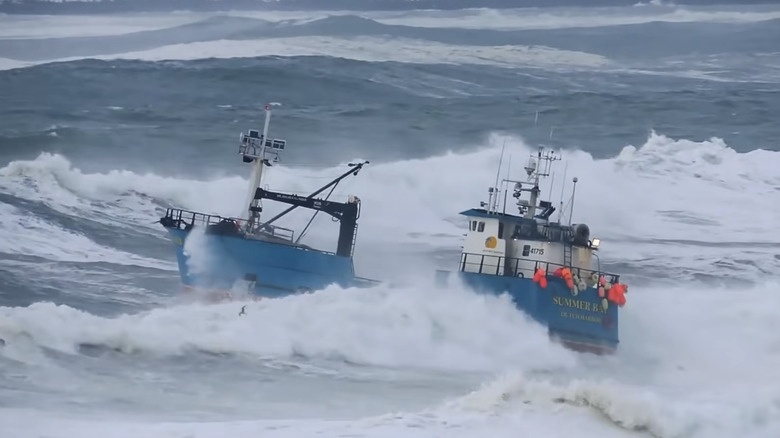How Fast Can The Deadliest Catch Vessels Actually Go
Longtime fans of Discovery's "Deadliest Catch" will know that most of the boats we see within the series are constantly racing against the clock in order to fill their fishing quota for the season. This emphasis on time was even more pronounced back in Season 1 when the fleet was still operating under the rules of "derby style" king crab fishing — in which each crew was competing to see who could haul in as much crab as possible during each allotted fishing season (via NPR).
Although this extremely dangerous style of fishing was phased out prior to the start of the series' second season, the fleet still works around the clock to make sure they are not below quota by the time they arrive back at port. Despite the fact that the fleet's pace is much more relaxed than it was during the days of the derby system, these ships still have to cover an enormous amount of ocean in a relatively short time in order to pick up the required amount of crab each season.
Indeed, it might actually surprise some fans of the series to learn that the vessels we see in "Deadliest Catch" are actually moving extremely slow –- especially considering the show's emphasis on quick and efficient fishing.
The vessels can barely make it past 10 miles an hour
During an interview with FOX 11 Los Angeles, "Deadliest Catch" stars Keith Colburn and Johnathan Hillstrand explained that the ships are actually only moving between 8 to 10 knots at any given time. A knot is a unit of measurement representing nautical miles per hour. Because a nautical mile is slightly larger than a regular mile, a ship with a speed of 8 knots would be moving at around 9.2 miles per hour, while a ship with a speed of 10 knots would be moving at around 11.5 miles per hour.
Indeed, Colburn and Hillstrand explained that the extremely slow speed of their vessels is what often causes them to be caught in storms while shooting the series. "We got caught in that superstorm ... we're so far out there. People go, 'why don't you just go to port?' Well, it's faster than us," Hillstrand said. "When we hear about a storm, it's gonna hit us in less than a day."
The realization that these ships are routinely traveling at a pedestrian 10 miles an hour certainly casts several aspects of the series in a new light –- particularly the impact that storms have on these ships and the sheer amount of ocean they all have to cover at such a slow speed. Considering how slow these ships are actually moving, it's no wonder why the captains are always trying to get their work done as efficiently as possible.

